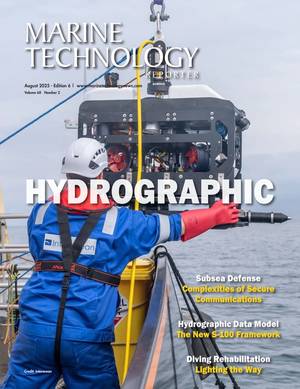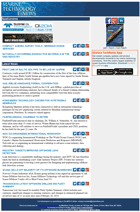
Voyis Support Launch: Professional Services for Underwater Visual Surveys & Photogrammetry
of data deliverables.Project Consultation: Expert guidance on survey design, mobilization planning, and best practices to align projects with specific goals.Onsite or Remote Acquisition Support: Professional assistance to ensure smooth operations, data integrity, and troubleshooting in real time.Data Processing & Photogrammetry: Transformation of image datasets into clean, accurate, and ready-to-use 3D models for engineering, analysis, or visualization.Through each of these services, Voyis emphasizes data quality assurance, reducing costly rework and ensuring survey efficiency.From the earliest

Oceaneering Upgrades Survey Vessel for Simultaneous Autonomous Missions
survey work, has been outfitted with new navigation systems, hull-mounted sensors, cloud-enabled data infrastructure, and a modernized engine room.The upgrade includes a dedicated Launch and Recovery System (LARS) for autonomous platforms and integration with Microsoft Azure for real-time data processing.“The Ocean Intervention II provides a step change in survey data acquisition productivity with the ability to simultaneously collect AUV, towed geophysical, and geotechnical data. We’re excited to offer this enhanced capability to our clients,” said Peter Buchanan, Senior Director

Sonardyne to Deliver Seabed Monitoring Kit for North Sea CCS Project
and Funding in Place for UK’s First Offshore CCS ProjectMonitoring of the site will begin in the summer of 2026 to provide baseline data for a duration of two years before the transportation and storage of captured CO2 starts.The seabed landers will be equipped with Sonardyne’s Edge data processing application, power management and acoustic through-water communications to enable long-term, remote battery-operated deployment.Each lander will also contain a suite of hardware including Sonardyne’s Origin 600 ADCP, Wavefront’s passive sonar array and multiple third-party sensors

Voyis Launches Deep Vision Optics for Underwater Imaging
feature and target detection, supporting machine learning applications with reliable automated analysis. Enhanced corner sharpness improves stability in photogrammetry and VSLAM processes, while higher depth of field ensures accurate photogrammetry, reducing manual intervention and accelerating data processing for faster, more reliable survey results.Deep Vision Optics represents a significant leap forward in underwater imaging technology, empowering operators with the tools needed to conduct more precise, efficient, and automated subsea inspections. Voyis remains committed to advancing the field

IQUA Robotics: SPARUS II AUV Tackles Multimodal Mapping for Exploration and Inspection
enable it to operate in challenging maritime conditions for a full workday. This small-class AUV can reach a maximum depth of 200 meters and can be easily operated from a variety of vessels by a team of two people.Available software tools simplify mission planning, monitoring, and rapid data processing, allowing users to quickly analyze the AUV’s findings while it remains on the surface, ready for the next mission. Alternatively, real-time data processing can be performed onboard, directly linking environment exploration with inspection tasks when a target is automatically detected.

Sonardyne, Echoview Software Collaborate to Enhance ADCPs
organisms, fish shoals and physical processes such as internal waves and sediment plumes. When combined with the ADCP's water velocity measurements, users gain unprecedented insight into the complete marine environment from a single instrument.Echoview is an advanced echosounder and sonar data processing software, offering capabilities that range from easy data visualization to sophisticated target detection and analysis. Echoview Software and Sonardyne have worked closely together to ensure that Origin ADCP users can begin processing their echosounder data with Echoview from day one.The Origin

2025 Janus Review: USV Industry Trends
, real-time data integration, and sophisticated AI algorithms - still developing and largely unproven in maritime environments.Reliable marine computer vision systems require specialized datasets and algorithms tailored to challenging sea conditions, still under active development.Real-time sonar data processing and reliable AI classification of underwater obstacles remain significant technological hurdles, demanding continued research and testing.Intelligent self-diagnostics paired with adaptive mission-planning capabilities would revolutionize USV autonomy. Integrating real-time diagnostics with autonomous

Cathx Ocean Unveils New INKA Camera
Ocean is set to solve this problem with the launch of INKA Iris at UDT 2025.INKA is Cathx Ocean’s onboard hardware processing platform, designed to bring real-time AI-driven decision-making to subsea vehicles. Iris is the first camera built on the INKA platform, delivering imaging and onboard data processing in a compact, power-efficient package. Built on customer feedback and real-world testing, INKA Iris, combined with the Clarity Autonomous Perception Platform, enables subsea vehicles to run AI models directly on the sensor, significantly enhancing real-time data analysis.Unlike traditional systems

Smarter Than Us
designed to independently perform offshore wind inspections, only reporting back at the end of the mission.The potential of quantum computing will be considered in an upcoming issue of Marine Technology Reporter magazine. Quantum computing is expected to dwarf the current potential that AI holds for data processing and interpretation. Where a supercomputer might take a year to crunch a load of data, it could take just a few hours with a quantum computer.The potential this power has for further advancing AI is only just being explored
 August 2025
August 2025





